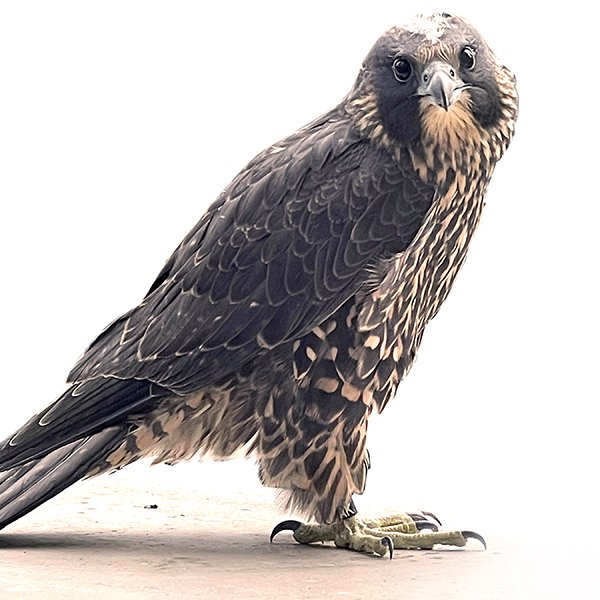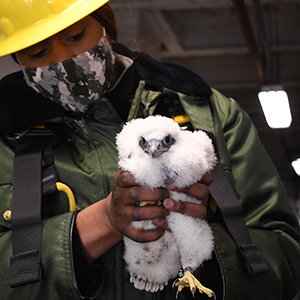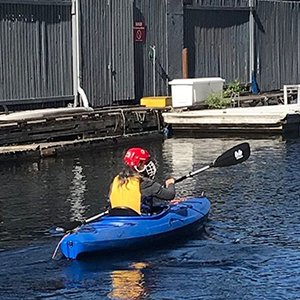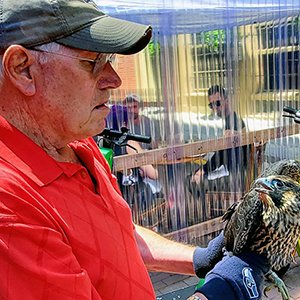URC Update | Winter 2021
2021 Puget Sound Peregrine Project: Annual Report
We followed ten peregrine nests this year in the Puget Sound region. Fledglings variously launched, hit windows, drowned, exhilarated us with triumphant flights, and left us wondering about the fates of the survivors.
For the six nests we could follow closely, 18 eggs hatched, two young died or disappeared before fledging, 16 fledged, and five were known dead within a few weeks. That leaves at most 11 juveniles still out there. Although the losses were searing, a survival rate (i.e., not known dead at three months post-fledging) of 70% is as good as it gets for peregrines.

Female fledgling 79-AK survived for a few weeks in downtown Seattle before she died from a window collision. Matthew Hale
Seattle
- 1201 Third Ave
- Portage Bay/520 Bridge (WSDOT)
- West Seattle Bridge (SDOT)
- East Channel Bridge (WSDOT)
- Waterfront grain terminal (Louis Dreyfus)
- AGC building on Lake Union (AGC)
Tacoma
- Heritage Bank downtown
- 509
- Exit 132/Bradken
Renton
- Boeing-Renton hangar




Top to bottom: Khepera Townes, engineer at Wright Runstad, meets a newly banded eyass (Matt Cryan); on banding day in downtown Tacoma, Patti grabs a nestling to relay to Ed (Fergus Hyke); Jenn on fledgling vigil at Portage Bay (Patti Loesche); Jack Geary rescues 1201 3rd Ave. fledgling 85-AK (Hugh Black). Right: 17-AD, the resident adult male at the Portage Bay/520 site, perches near the nest. (Matt Cryan)
The downtown Seattle nest hatched four weeks earlier than usual. On May 24, Patti Loesche and Martin Muller banded four young, three females and a male. Females 79-AK and 85-AK died from window hits shortly after fledging:
79-AK was found by the loading dock of her natal building by Rudy Reyes, who has been with Wright Runstad since peregrines first nested there in 1994. Patti delivered her to PAWS Wildlife Center, where she was euthanized because of multiple injuries.
85-AK was trapped in a rooftop enclosure over the hot Memorial Day weekend. She could not fly and was rescued by Patti, rehabbed at PAWS, and released from her rooftop nest site. Not long after, she was found in Post Alley by Jack Geary of the Owl ‘n Thistle. Jack took her to PAWS, not knowing it was her second trip. Unfortunately, 85-AK had hit another window, and this time she didn’t survive.
Likewise, at the downtown Tacoma nest, both banded fledglings died from window hits. A third chick died in the nest.
Elsewhere in Tacoma, Roger Orness reported that the 509 site incubated for nearly six weeks before abandoning. In better news, the Exit 132/Bradken site fledged three. No reports of fledglings from local rehab clinics, so we hope for three 2021 survivors for Tacoma. The resident male here fledged from the West Seattle Bridge (see below).
At the Portage Bay/520 Bridge, the risk to fledglings was drowning. Patti again marshalled a navy, as when the same pair nested at University Bridge in 2019. This year’s peregrine navy involved daylong patrols from shore and by kayak, with stunning coordination by Jenn Kovach. Of the three Portage Bay young, one drowned. The other two were rescued, banded, and released at the bridge after short stays at PAWS, one before and one after the brutal triple-digit June temperatures. These two fledglings would not have survived their natal flights without extraordinary vigils by Jenn, Matt Cryan, Venerable Dhammadinna, Gail Joice, Curt Kovach, and Mary Anne Thorbeck.
WSDOT plans to replace the Portage Bay Bridge in a few years, and an active peregrine nest would gum up the works. We appreciate that WSDOT has included URC in its planning. The resident adult male,17-AD, is the son of a bridge nester himself (East Channel Bridge, class of 2015), who survived his own water fledging under Ed Deal’s surveillance. As a breeding adult in Seattle, he too has chosen to nest on bridges—Ballard, University, and now Portage Bay—a succession of poor sites.
 The East Channel Bridge pair led us on a merry chase from both sides of the bridge. The adults seemed to do all the right things, but not very often. Finally, begging screams were heard from within the bridge, and food deliveries were pinpointed to the probable nest site. After many visits by veteran observers, one fledgling was finally seen, once.
The East Channel Bridge pair led us on a merry chase from both sides of the bridge. The adults seemed to do all the right things, but not very often. Finally, begging screams were heard from within the bridge, and food deliveries were pinpointed to the probable nest site. After many visits by veteran observers, one fledgling was finally seen, once.
Seattle’s shining success was at the West Seattle Bridge, with four fledglings and no known mortality. One of the chicks, 53-AK, flunked flight school, spent time at the PAWS Peregrine Spa, and was released.
The West Seattle adults are banded (female 28-V from Olympia, male 38-N from Tacoma), so we know they have been residents there for years. We long banded the West Seattle fledglings in the past, but have not had permission to do this in recent years. Previously banded young have contributed to our limited information on peregrine fledgling survival and dispersal in our region. As just one example, West Seattle male A-79 fledged in 2015. He has nested in Tacoma at the Exit 132/Bradken site since 2017, producing 14 fledglings.
Peregrines again nested inside the Boeing Renton 737 assembly hangar. As happened last year, Washington Department of Fish and Wildlife took the four young and placed them with falconers.
Maybe next year. Both the Seattle waterfront grain terminal and the AGC building on Lake Union hosted courting pairs, each a one-year-old female and an adult male. Martin negotiated access with Louis Dreyfus to put a nest box on the grain terminal roof, but the birds didn’t progress to egg-laying at either site.
Several of us joined Roger for a respite from the perils of peregrine fledging and enjoyed viewing young at successful cliff nests at Snoqualmie Falls (fledged three) and Rattlesnake Ledge (four).
URC was interviewed for an article on Northwest peregrines, published in the March/April 2021 issue of the AAA magazine Journey Puget Sound. URC’s Fergus Hyke in Tacoma contributed several phenomenal photographs.

17-AD, the resident adult male at the Portage Bay/520 site, perches near the nest. (Matt Cryan)
We are grateful to Wright Runstad for their massive support of the flagship peregrine site at 1201 Third Avenue for the past 28 years, providing outstanding logistical help with banding opportunities and a falcon cam. They have made possible the longest and best-observed history of the comeback of peregrines in the Puget Sound region. Since 1994 71 eggs have hatched at this site, and 41 survived or were not known dead at least three months after fledging.
Our monitoring efforts also depend on ground support from many others: WSDOT, PAWS, the dedicated volunteers who spend much of June watching over the hair-raising period of peregrine fledging, and many valuable observations. We are all doing our best for our region’s peregrine falcons.
In gratitude,
Ed Deal, Patti Loesche, Martin Muller
Urban Raptor Conservancy
https://urbanraptorconservancy.org
info@urbanraptorconservancy.org
As 2021 comes to an end, we are grateful for the passion and support of the many of you who enable our work: grants from Patagonia and the Peter Mason Family Charitable Trust, many individual donations, and hundreds of volunteer hours.
This year, we found active nests for 69 pairs of Cooper’s hawks and 10 pairs of peregrine falcons. We rescued three fledgling peregrines and ensured the release of six Cooper’s hawks trapped in buildings. We also banded 74 Cooper’s hawks, 10 peregrines, and 90 rehabilitated raptors at PAWS. Finally, in our collaborative study with PAWS on rat poison in raptors, we began data analysis on 125 raptors in phase 1 and launched phase 2 to test for new toxins in more species, including snowy owl pellets. With you, we are achieving our goals and are able to continue our long-term work.
There is much to be done. Your support is an investment in the preservation and protection of our region’s urban raptors. Visit https://urbanraptorconservancy.org/support-urc
We thank you.